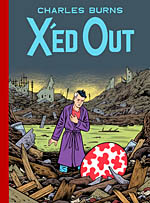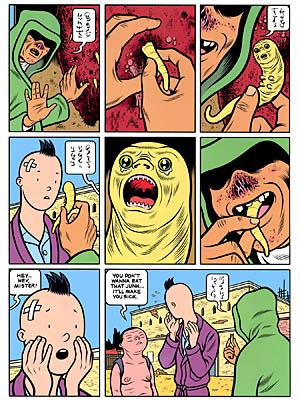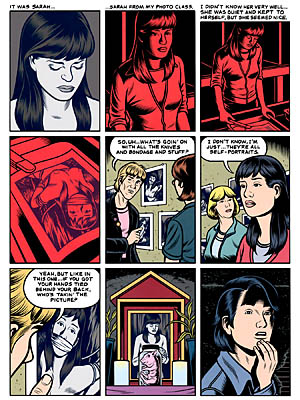 By Charles Burns
By Charles Burns
56 pages, color
Published by Pantheon Books
Charles Burns is a comic creator whose art is easy to recognize, but hard to categorize save that it appears to exist to try and make the reader uncomfortable. From my first experience with Burns’s work as a live-action adaptation of his story "Dog Boy" on Liquid Television, to his collections of short stories from Fantagraphics, and his most recent magnum opus Black Hole (which took years in the making but was utterly worth the wait), each piece has inspired a strange combination of wanting to see more and feeling the need to turn away from the view. With Burns’s new book, X’ed Out, he’s carefully stepped away from the "mutation as venereal disease" metaphor of Black Hole into a strange narrative that shifts back and forth between dream and reality.
 X’ed Out opens with a sequence set in what is easily interpreted as a dream world for Doug. Like many dreams, there’s a different sort of logic applied as he stumbles from one setting to the next, shifting from a toxic ruin in night, to an alien desert world by day simply by stepping through a door. It’s hard to warm to this Doug, drawn in a stripped down fashion a la Tintin, because in typical dream-logic fashion he shows remarkably little control over anything that happens. In many ways it’s not that he’s moving through this world, but rather that the world is moving around him while he’s staying perfectly still.
X’ed Out opens with a sequence set in what is easily interpreted as a dream world for Doug. Like many dreams, there’s a different sort of logic applied as he stumbles from one setting to the next, shifting from a toxic ruin in night, to an alien desert world by day simply by stepping through a door. It’s hard to warm to this Doug, drawn in a stripped down fashion a la Tintin, because in typical dream-logic fashion he shows remarkably little control over anything that happens. In many ways it’s not that he’s moving through this world, but rather that the world is moving around him while he’s staying perfectly still.
When shifting from the "dream world" to the "real world," our protagonist in many ways becomes more hapless. Getting angry over strawberry over blueberry Pop-Tarts (personally I’d rather have the strawberry), breaking out in tears over the doorbell and fearing answering it, retreating to bed with more pain pills, Doug is someone teetering in-between a nervous breakdown and a full-blown addiction. Even though his other worldly self initially seems to be getting dragged from one situation to the next with no real control over his own life, it’s a little startling to see that his dream self is somehow the idealized one.
There’s a third setting here, though, which is a flashback of the "real world," before Doug gets a massive head wound (depicted with a large bandage on "real world" Doug’s head and a tiny X of tape on "dream world" Doug) and when he’s first meeting Sarah. It’s only here that Burns’s story seems to start truly connecting the dots, as we see not only those initial sparks of attraction between Doug and Sarah, but also hear the words of her unseen, threatening boyfriend. Burns wisely keeps this tentative foe off-panel for all of X’ed Out, letting him be a monster that the reader has to imagine and as a result make even more menacing. It’s this portion of X’ed Out that I suspect people will find the most accessible in this initial installment; it feels like it’s the foundation that the others are built on, and understanding them appears to rely on these flashbacks.
 The further you read into X’ed Out (and as the book goes back to the initial setting), Burns starts playing with images from one setting bleeding into another. Some are as simple as repeated dialogue ("You like eggs?") that echo from the past into the present. Others can’t help but feel more sinister, as an accidentally fertilized egg makes you wonder if this is a hint of what’s still to come between Doug and Sarah, especially with the earlier image of that same dead creature floating on a river of red sewage out of a pipe. With Sarah appearing as a "queen" to be used as a "new breeder" in the far-off hive, things are rapidly ramping up into the realm of disturbing. It feels like this dream world is the only way that Doug can interpret and fully comprehend his own life; what started as an escape mechanism fueled by doses of painkillers is turning into a dangerous coping mechanism.
The further you read into X’ed Out (and as the book goes back to the initial setting), Burns starts playing with images from one setting bleeding into another. Some are as simple as repeated dialogue ("You like eggs?") that echo from the past into the present. Others can’t help but feel more sinister, as an accidentally fertilized egg makes you wonder if this is a hint of what’s still to come between Doug and Sarah, especially with the earlier image of that same dead creature floating on a river of red sewage out of a pipe. With Sarah appearing as a "queen" to be used as a "new breeder" in the far-off hive, things are rapidly ramping up into the realm of disturbing. It feels like this dream world is the only way that Doug can interpret and fully comprehend his own life; what started as an escape mechanism fueled by doses of painkillers is turning into a dangerous coping mechanism.
Burns uses two different styles of art in X’ed Out; the first is the previously mentioned Tintin homage, the second Burns’s normal style. Don’t mistake the first for being less dramatic than what you’re used to from Burns. From the ruined buildings along the banks of the green river, to the shriek of the yellow maggot as it screams before being eaten, there’s still a lot of punch in this slightly different take on Burns’s art. While the people look much more simple (especially "dream world" Doug and Sarah, perhaps an attempt by Doug’s subconscious to try and simplify the hard-to-handle reality Doug is dealing with), there’s still a rich detail in the surroundings that make up the alien landscapes on display.
Burns’s more typical art style is as strong as ever. His characters feel almost greasy with the way his slick ink line oozes across the page, and even when confining himself to a nine-panel grid (although Burns knows when on rare occasion to merge panels into larger ones, or even break the grid entirely) he’s able to bring a lot of dramatic moments into his art. His tight focus doesn’t let the viewer’s eye ever meander away from the main focus of each drawing, instead dragging us into the center and locking our attention onto the most important piece of the scene. This is also the first time I can remember seeing a full-color story by Burns, and it’s excellent. From the deep reds of the dark room, to the muted colors of the "real world," and then cranked up all the way into glorious pop pastels in the "dream world," Burns uses color as an integral part of his art, not something that is casually added in to up sales.
X’ed Out is an intriguing comic, but as the first installment in several to come (I believe it’s scheduled to be a trilogy), it’s slightly hard to get a firm grasp on the story as a whole. I liked this first chunk here, but understand that there’s no real ending with this book, and that it’s a book that will ultimately need to be re-judged once the entire story is published. For now, though, it’s a tantalizing first step into a new story by Burns, and definitely worth your attention.
Purchase Links: Amazon.com | Powell’s Books
